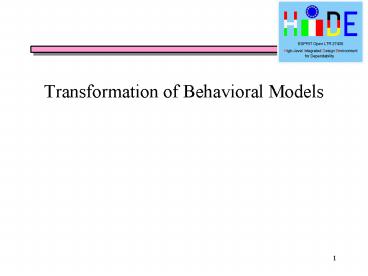Transformation of Behavioral Models - PowerPoint PPT Presentation
1 / 15
Title:
Transformation of Behavioral Models
Description:
structure and behavior of the system, and each view focuses on a ... Elevating. Rotary table. Arm2. 14. Model of a Fault-Tolerant Production Cell. Demonstrator ... – PowerPoint PPT presentation
Number of Views:38
Avg rating:3.0/5.0
Title: Transformation of Behavioral Models
1
Transformation of Behavioral Models
2
Views
'The architecture of a software-intensive system
can best be modeled by
five interlocking views, with each view being a
projection into the
structure and behavior of the system, and each
view focuses on a
particular aspect of that system.'
(G.
Booch)
The UML-views are
design
view
process
view
the
(or static)
, the
(or dynamic)
, the
deployment
view
component
view
use
view.
, the
and, the
3
Behavioral Model
4
Dependability Evaluation
System Model
Dependability of System
5
Dependability Evaluation
Statecharts Sequence Diagrams Activity Diagrams
Behavioral Model
Analytical Model
Generalized Stochastic Petri Nets
Dependability
PANDA
6
Transformation of Statecharts to Generalized
Stochastic Petri Nets
7
Embedded Systems
Components are controllers and devices which
interact via actuator and sensor signals.
8
Behavioral Model of Embedded Systems
Example Statecharts where interactions between
the device and its controller are modeled by
guards over actuator and sensor states.
9
Main Transformation Steps
10
Transformation of the Behavioral Model
11
Fault-Injection
12
Fault-Injection
13
Demo example
Press2
Arm2
Press1
Arm1
Robot
Feed Belt
Elevating
Rotary table
14
Model of a Fault-Tolerant Production
CellDemonstrator
11 statecharts 20 state transition diagrams 72
basic concurrent states 14 sensor states 17
actuator states
15
Performance of the Fault-Tolerant Production Cell































